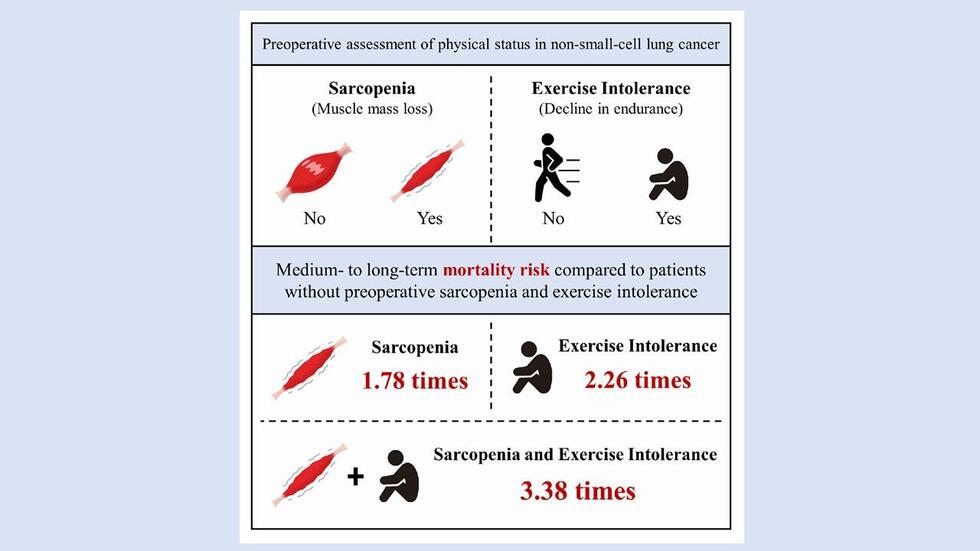
Medicine, Dentistry, and Pharmacy
April 23, 2021
Age-related muscle loss and walking abilities predict outcomes after lung cancer surgery
Patients with age-related muscle loss and poor walking abilities have worse prognoses after lung cancer surgery, new study finds
Lung cancer is a major global cause of mortality, reportedly accounting for 1.7 million deaths each year. The most common form of lung cancer is non-small-cell lung cancer (NSCLC), and early-stage NSCLCs can often be surgically resected. Unfortunately, some patients still experience poor outcomes after surgical resection, prompting further research on the relationship between a patient's preoperative status and the likelihood of good postoperative outcomes.
Given this need for information, Dr. Shinya Tanaka from the Department of Rehabilitation and Prof. Naoki Ozeki from the Department of Thoracic Surgery, Nagoya University, and their colleagues decided to investigate. Previous studies had identified some risk factors for mortality after NSCLC resection, including sarcopenia, which is defined as the progressive loss of muscle mass and strength and predominantly occurs in older individuals. Another known risk factor for unfavorable postoperative outcomes is poor physical performance as measured with the 6-minute walking distance (6MWD) test, which involves measuring how far a patient can walk on a corridor in the span of 6 minutes.
To Dr. Tanaka and Prof. Ozeki, these past findings clearly pointed to "the importance of comprehensively assessing a patient's preoperative physical state in order to determine his or her risks of poor outcomes." However, no previous study of postoperative outcomes in patients with NSCLC had considered both sarcopenia and physical performance. Dr. Tanaka, Prof. Ozeki, and their colleagues therefore decided to conduct a study that addressed this gap in research. Their findings appear in a paper recently published in the Journal of Cachexia, Sarcopenia and Muscle.
The researchers analyzed data from 587 patients with NSCLC who underwent resection surgeries at Nagoya University Hospital between 2014 and 2017. They focused their analyses on determining how preoperative sarcopenia and exercise intolerance (defined as the inability to walk further than 400 meters on the 6MWD) influenced a patient's risk of mortality during the postoperative follow-up period, which lasted for 3.1 years on average.
The researchers' analyses showed that patients with preoperative sarcopenia had a 1.78-fold higher likelihood of death during follow-up than their peers without preoperative sarcopenia and exercise intolerance. Furthermore, patients with preoperative exercise intolerance had a 2.26-fold higher risk of death than patients without preoperative sarcopenia and exercise intolerance. However, the strongest effects emerged when sarcopenia and exercise intolerance coincided: patients who had preoperative sarcopenia and preoperative exercise intolerance had a 3.38-fold higher likelihood of death than patients who were free of sarcopenia and exercise intolerance prior to surgery.
These findings have important implications for the preoperative assessment of patients with NSCLC. In short, when oncologists are attempting to predict postresection prognoses, they should comprehensively consider a patient's physical status because variables like sarcopenia and exercise intolerance interact with each other to increase a patient's risk of mortality.
A new study by researchers from Nagoya University revealed that preoperative sarcopenia and exercise intolerance are associated with higher risks of medium-to-long-term mortality in patients with non-small-cell lung cancer. (Credit: Shinya Tanaka and Naoki Ozeki from Nagoya University)
Dr. Tanaka and Prof. Ozeki hope that their findings "may contribute to the establishment of intervention methods to improve the prognoses of patients with NSCLC." More broadly, they hope that "more people will realize the importance of nutrition and exercise and try to lead healthier lives."
Reference:
The paper, "Preoperative paraspinous muscle sarcopenia and physical performance as prognostic indicators in non-small-cell lung cancer," was published in Journal of Cachexia, Sarcopenia and Muscle on March 4, 2021, at DOI: 10.1002/jcsm.12691.
Authors:
Shinya Tanaka1, Naoki Ozeki2 , Yota Mizuno1, Hiroki Nakajima1, Keiko Hattori1, Takayuki Inoue1, Motoki Nagaya1, Takayuki Fukui2, Shota Nakamura2, Masaki Goto2, Tomoshi Sugiyama2, Yoshihiro Nishida1,3 & Toyofumi Fengshi Chen-Yoshikawa2
1Department of Rehabilitation, Nagoya University Hospital; 2Department of Thoracic Surgery, Nagoya University Graduate School of Medicine; and 3Department of Orthopaedic Surgery, Nagoya University Graduate School and School of Medicine
Media Contact
Shinya Tanaka
Email: s-tanaka@med.nagoya-u.ac.jp
Naoki Ozeki
Email: naokiozeki@med.nagoya-u.ac.jp